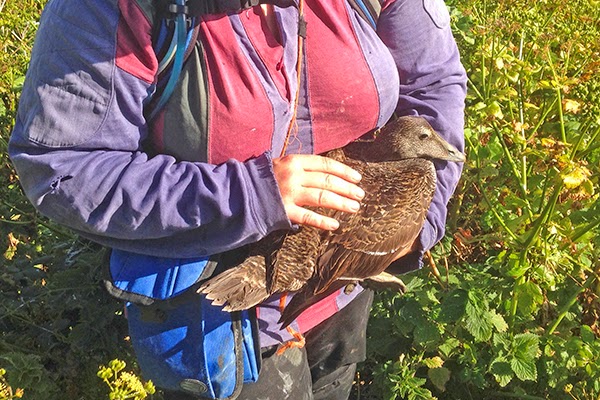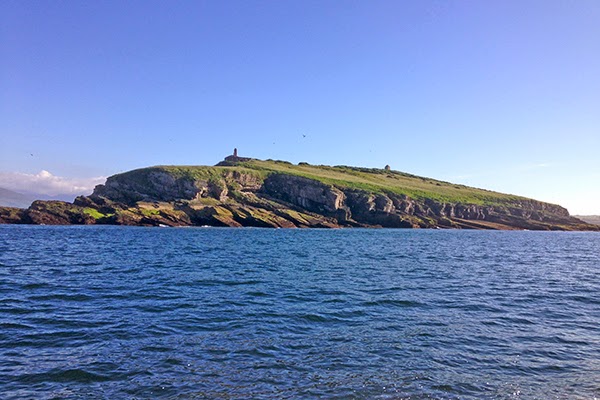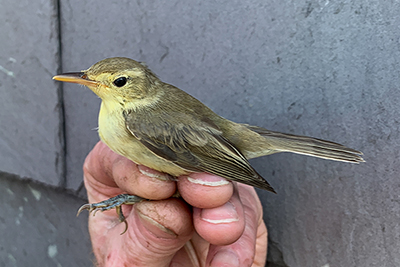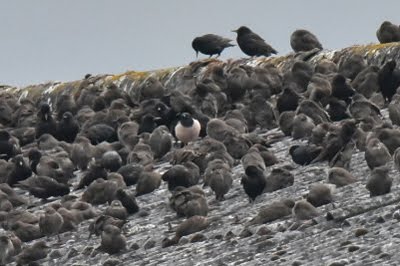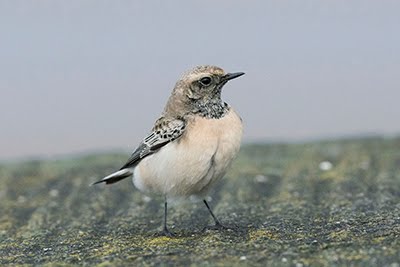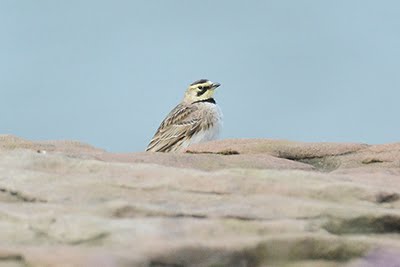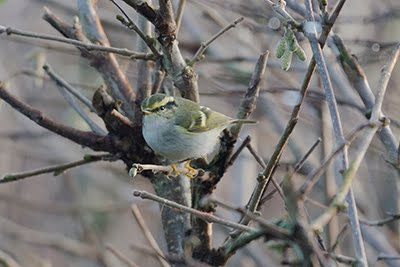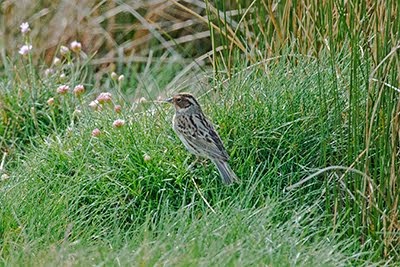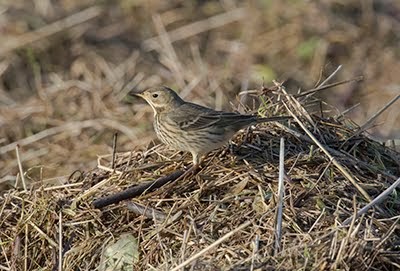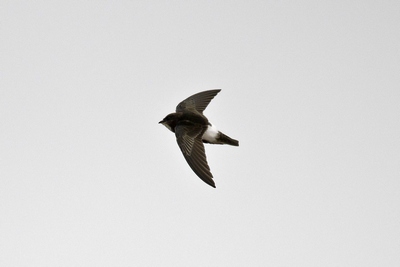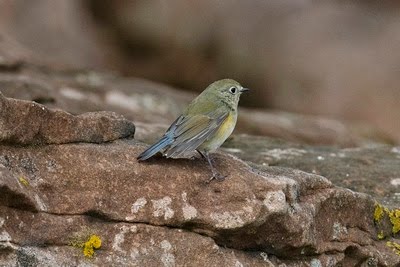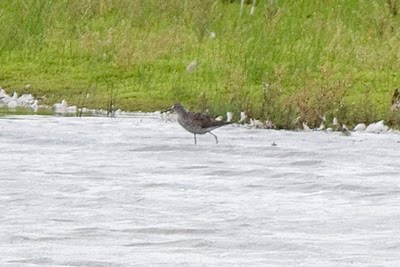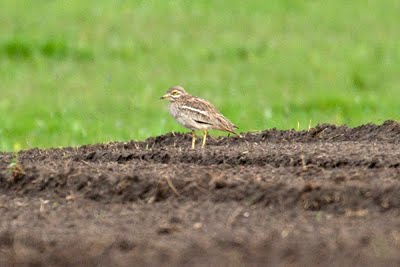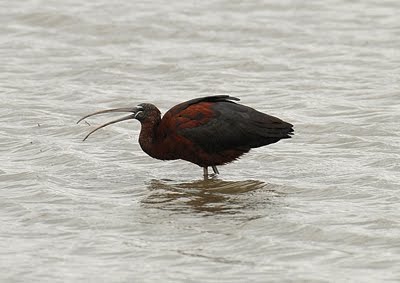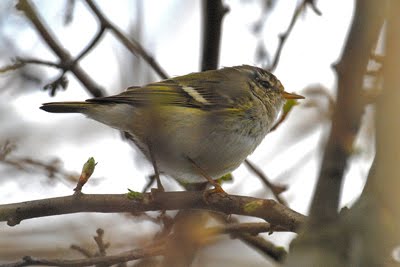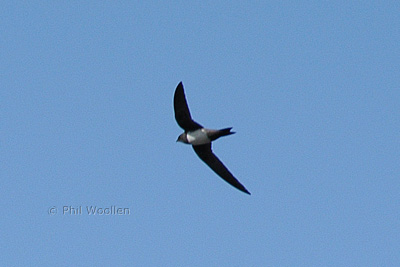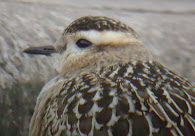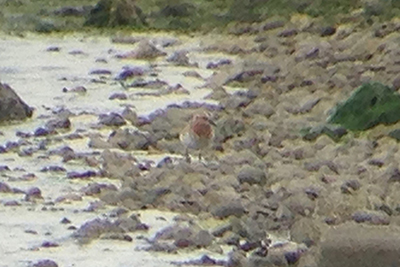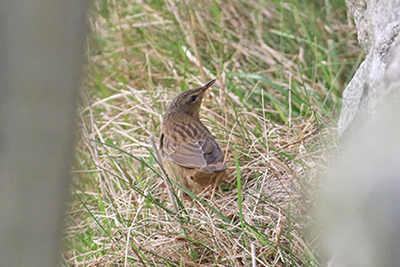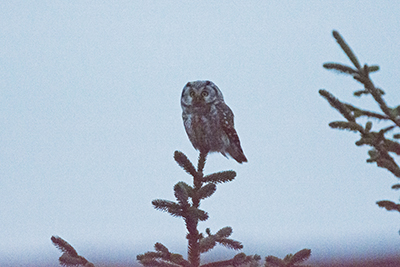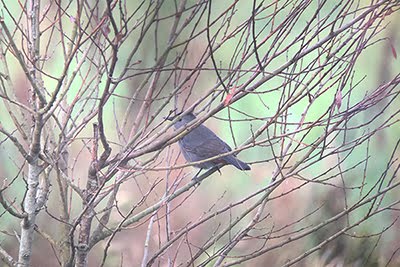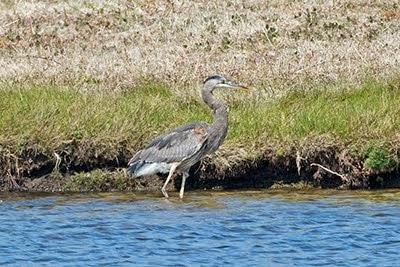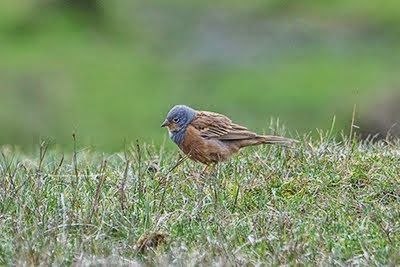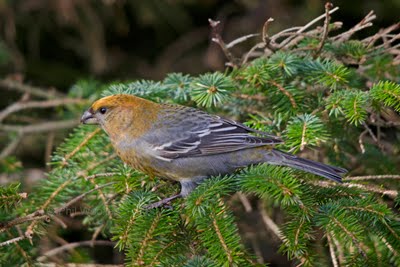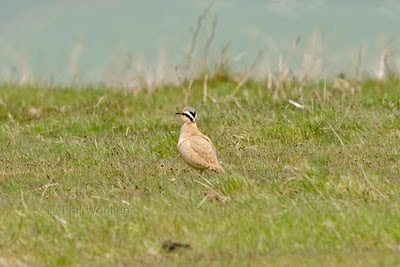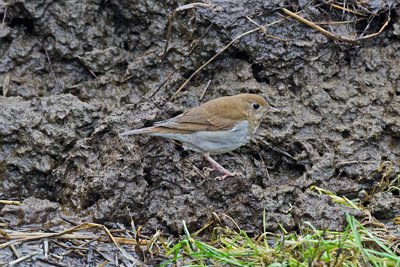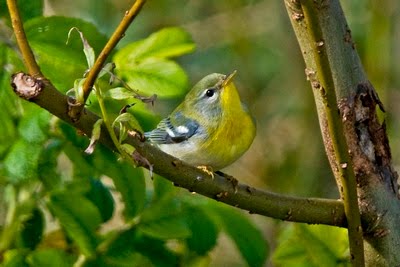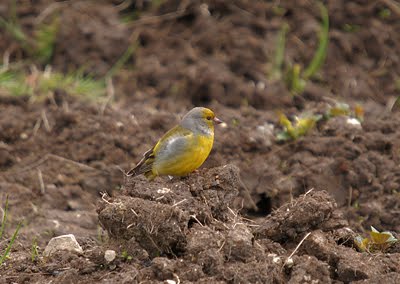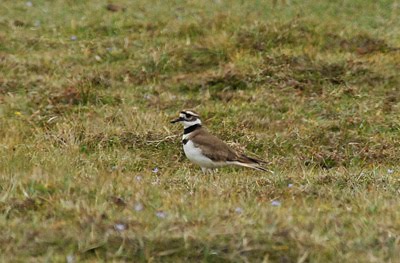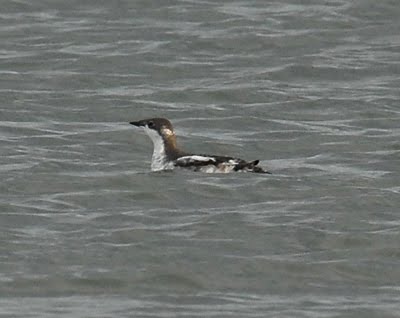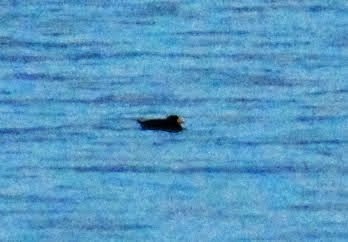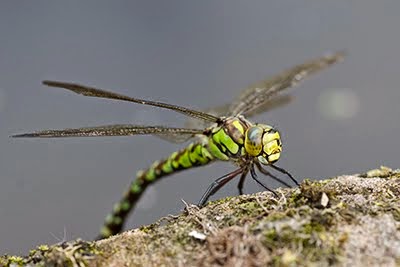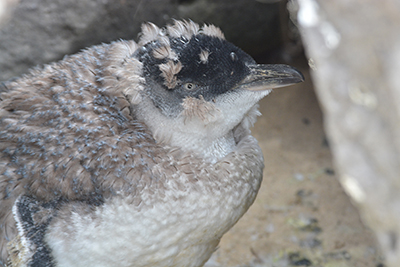Trip two of the organised trips to Puffin Island to monitor / ring the seabird pullus was scheduled for Saturday morning. The weather was unbelievably cold when I set off with driving rain and a strong breeze. By the time I arrived at Beaumaris at 7.30 am and met up with the rest of the team the rain had stopped but Jason, the boatmen, was worried the swell caused by the NE breeze would prevent us landing on the only beach on the island. We'd have to go in commando style jumping off the front of the boat and into the water if necessary. As it happened although there was a swell we managed to get ashore without anyone getting to wet or losing their dignity by falling in!
The main purpose of the trip was to ring a sample of 250 Cormorant chicks of which 50 were to be colour ringed, ring as many of the Guillemot chicks as we could manage, a few more Razorbills if we could find them and, time allowing, a few gulls.
The Cormorant colony is a noisy smelly place and the whole team were soon covered in guano and regurgitated fish. Its the largest coastal colony in the UK and involves a fair bit of scrambling around on slippery slopes.
Ringing Cormorant chicks definitely isn't for the faint hearted or fastidiously clean. As well as the regurgitated fish suppers and lethally aimed 'whitewash' they have razor sharp bills and inflict serious damage. They also go for your eyes.
I was part of the colour ringing team along with Rachel & Ollie. Ollie & I fitted the metal BTO rings and Rachel then colour ringed the birds with a green darvic engraved with tree white letters. It took time as fitting the colour rings involves opening them up to get over the birds leg and then gluing them with marley cement to stop them opening up. Sellotape is wrapped round them so they don't spring open until the glues dried.
You're crouched in uncomfortable positions on a slippery slope trying to handle good sized birds that want to harm you. All good fun.
Some of the Cormorants were still on eggs or very small chicks.
Cormorant chicks don't have much going for them and being in the colony is like a scene from the Jurassic period with Pterodactyls all around.
After finishing the Cormorant colony it was time for a brief lunch before Ian & I set off with Mike to ring a few gulls. Herring, Greater Black-backed and lesser Black-backed Gulls all breed on Puffin Island and as with the Cormorants there is a wide age range with newly hatched chicks:
And adolescents looking to start a fight.
They're pretty adept at hiding in the long vegetation - brambles and nettle patches are preferred so you end up with even more scratches and nettle stings.
Once we'd finished with the gulls we joined Steve and the rest of the team to ring the Guillemot chicks. The team was divided into two with the more experienced people joining Steve climbing down the dreaded chimney to a large area of Guillemot nesting ledges. By now it was drizzling slightly - not the best situation weather to be clambering down already slippery cliffs! As well as the Guillemot chicks we ringed whatever Razorbills we found that we'd missed during the previous visit and finished off the rest of the Shag rings. Adult Guillemots are gorgeous looking birds and its always a privilege to see them close up.
The noise in the breeding ledges is deafening and adds to the assault on the senses.
By now we were completely covered in guano and vomit and half deaf. Not only were we getting deafened by the Guillemots and Razorbills but the Kittiwakes were joining in from their ledges and just for good measure crapping on us from above.
With time pressing we yomped back to the beach to find Jason already waiting to ferry us off. A change of cloths back at the Landrover and I was home by 8 pm ready for my curry a beer, a hot shower and the chance to rub some antiseptic into the numerous bites and scratches.
Until the next visit...................
Foot note: Steve sent an email round last night. 690 birds ringed Saturday including 306 Guillemots & another 36 Razorbills. No wonder I was knackered and felt I had arms like Popeye Sunday.
30 Jun 2014
23 Jun 2014
Autumn's round the corner!
With our 28th wedding anniversary on the longest day, Saturday, it was as well things were fairly quiet and I wasn't dashing off to Hilbre, Puffin Island or a mad long distance twitch somewhere! It was a nice sunny weekend spent enjoying good company and good food with very little birding done. The nice weather meant I could carry out some promised chores like painting the garage door whilst keeping one eye on the bird news and the occasional glance upwards to the sky in case a Black Kite or Honey Buzzard drifted over.
The garden is full of young birds at the moment and the warm spell seems to have resulted in good fledgling success. Dunnocks, Robins, Goldfinches and Chaffinches are joining the Blue & Great Tits in emptying the seed feeders daily and the garden is full of the calls of House Sparrows. These have studiously ignored the nest boxes I put up for them and must be nesting in the eaves of local houses. A male was singing on the roof a few feet above one of the boxes the other day but didn't seem to be going in the box.
Swifts seem to be doing well & I'm often hearing them over the house on warm evenings. With the weather to warm to walk much most of the photography has been limited to garden birds - with the occasional visit form our local Blackcap!
A new macro lens to play with will open up new photographic possibilities!
Now the longest day is behind us Autumn is just round the corner and it won't belong before the return migration is in full swing.
The garden is full of young birds at the moment and the warm spell seems to have resulted in good fledgling success. Dunnocks, Robins, Goldfinches and Chaffinches are joining the Blue & Great Tits in emptying the seed feeders daily and the garden is full of the calls of House Sparrows. These have studiously ignored the nest boxes I put up for them and must be nesting in the eaves of local houses. A male was singing on the roof a few feet above one of the boxes the other day but didn't seem to be going in the box.
Swifts seem to be doing well & I'm often hearing them over the house on warm evenings. With the weather to warm to walk much most of the photography has been limited to garden birds - with the occasional visit form our local Blackcap!
A new macro lens to play with will open up new photographic possibilities!
Now the longest day is behind us Autumn is just round the corner and it won't belong before the return migration is in full swing.
16 Jun 2014
1st Puffin Island ringing trip of the year.
A team of seven met up in the Beaumaris carpark at 07.45 Saturday morning for the 20 minute boat trip across to Puffin Island. Although still a bit chilly it was obvious it was going to be a glorious day and the sea was like the proverbial mill pond.
Landing on the only beach on the island it was first things first as Steve gave us a briefing of the days programme and we stashed clean clothes and wellies for later use!
This years 1st trip was slightly delayed as the birds were late arriving back on the breeding ledges probably due to the severe storms we had last November meaning many of them hadn't reached breeding condition until later in the year. Its to early to say how breeding numbers have been affected and that analysis will have to wait until the end of the season when numbers can be computed.
Today's trip was mainly to ring Razorbill and Shag pullus with the additional aim of catching as many adults as we could without losing too many digits!
We soon encountered our first Shag chicks and got our first coverings of guano! I was lucky enough to ring an adult male Shag - the first I'd been able to ring.
Razorbill (and Guillemot) chicks don't stay on their natal cliffs until they're fully grown but head for the sea before they can fully fly. The young bird below will soon be off and join its parents at sea where it'll complete its transition from fluffy toy to stunning adult. Note the filthy state of the ringer (me). A seabird colony isn't the place to be if you're fastidious about keeping clean!
Landing on the only beach on the island it was first things first as Steve gave us a briefing of the days programme and we stashed clean clothes and wellies for later use!
This years 1st trip was slightly delayed as the birds were late arriving back on the breeding ledges probably due to the severe storms we had last November meaning many of them hadn't reached breeding condition until later in the year. Its to early to say how breeding numbers have been affected and that analysis will have to wait until the end of the season when numbers can be computed.
Today's trip was mainly to ring Razorbill and Shag pullus with the additional aim of catching as many adults as we could without losing too many digits!
We soon encountered our first Shag chicks and got our first coverings of guano! I was lucky enough to ring an adult male Shag - the first I'd been able to ring.
Jamie & Noah ringing Shag pullus.
As we reached the boulder fields we started finding Razorbill chicks and nest still with eggs in holes beneath the rocks. Razorbill nests aren't really nests at all but at least they lay their eggs beneath boulders and not on exposed ledges like the Guillemots. One of the evolutionary consequences of this is that Razorbill eggs are more rounded and less pointed than Guillemot eggs. A pointed egg won't roll off the ledge but will spin on its axis.
Razorbill chick just emerging from its egg - the egg tooth at the tip of the bill is clearly visible.
Adult Razorbills are well armed to fend for themselves and I've got a fair few scars inflicted whilst trying to pass them to others to process in such away that they didn't get 'razored'. The chicks are impossibly cute though.
Razorbill (and Guillemot) chicks don't stay on their natal cliffs until they're fully grown but head for the sea before they can fully fly. The young bird below will soon be off and join its parents at sea where it'll complete its transition from fluffy toy to stunning adult. Note the filthy state of the ringer (me). A seabird colony isn't the place to be if you're fastidious about keeping clean!
Hopefully this bird will return to breed in 4-5 years once its reached maturity.
After a hectic few hours of hard graft climbing up and down cliffs and lying flat on your belly peering under boulders or grappling with Razorbills & Shag chicks (also well armed to defend themselves and always make a stab for your eyes) a lunch break is welcome and we always head up to the old telegraph station at the top of the island for a chance to refuel. This is always a reminder of 'my' other island, Hilbre, as both were used by the Liverpool Dock & Harbour Company as telegraph stations. Today the view was stunning with sail boats passing beneath us and the Great Ormes Head in the distance and surrounded by calling gulls.
Lesser black-backed, Greater and Herring Gulls bred hear and there were some good sized chicks roaming around in the long grass as well as some nests still with eggs. Including some which were just 'pipping' as the youngsters use their egg tooth to escape from the shell.
With time running out the team split up with Steve asking me to take a stick of rings and work one small area of cliff for Razorbills before joining the rest of the team on the final accessible area before heading back to the beach. We were on the island for 10 hours and in that time had probably covered more vertical miles than horizontal, ringed at least 150 Shag chicks and probably the same number of Razorbills, recaptured or ringed about 20 adult Razorbills and (personally) drunk 4 litres of water!
However, here was time for one more stunning surprise and a ringing tick for Rachel when Steve caught a female Eider by hand. Only the 2nd to be ringed on Puffin Island. What a gorgeous bird to see close up.
A close examination showed her to have at least three generations of feathers meaning she has undertaken at least one 'eclipse' suggesting she is as least 3 calender years old. The plumage patterning was very suggestive of Woodcock - another bird superbly equipped for cryptic camouflage.
Arriving on the beach we cleaned up as best as we could and changed into cleaner cloths for the boat journey back to Beaumaris - a tired but happy team. The weather had been kind to us and there were plenty of birds to ring. Leaving the island behind us to its avian inhabitants until the next trip in a few weeks time.
I arrived home around 20.45, grabbed a well needed shower, some dinner and sat down for a well deserved beer. Halfway down the 2nd I fell asleep on the couch and missed the end of the film we were watching before crawling, feeling battered and bruised, to bed - at least this time I wasn't sun burnt as I'd remembered both the sunscreen and a hat!
9 Jun 2014
A single Swallow has made my summer
We went back to the farm t oring some more Swallow chicks recently. 2 nests with good healthy chicks. As well as the chicks we try and catch a few adults hoping to get a returning bird from a previous year.
This time we were lucky as we caught an adult female I'd ringed as an adult in 2013. Showing incredible site fidelity she was back nesting in the same stable block. Being ringed as an adult in 2013 means she's made the trans-Saharan crossing to South Africa and back a minimum of two times in her life although she could be older.
Unfortunately numbers of breeding pairs are down on previous years and (at the the moment) there are only three occupied nests from a high of 6-7 a few years ago. Its very sad - the farm buildings haven't changed in over a hundred years and there are plenty of vacant nest sites.
Birds from this farm have been re-trapped in the Orange Free State, South Africa and Leighton Moss RSPB in Cumbria. Interestingly the Cumbrian bird was ringed as a chick in the nest and later the same year re-trapped in a Swallow roost at Leighton Moss - ringing recoveries have shown that young birds wander quite long distances throughout the UK before making their first migration and even, as with this bird, heading north rather than meandering south towards the coast.
This time we were lucky as we caught an adult female I'd ringed as an adult in 2013. Showing incredible site fidelity she was back nesting in the same stable block. Being ringed as an adult in 2013 means she's made the trans-Saharan crossing to South Africa and back a minimum of two times in her life although she could be older.
Unfortunately numbers of breeding pairs are down on previous years and (at the the moment) there are only three occupied nests from a high of 6-7 a few years ago. Its very sad - the farm buildings haven't changed in over a hundred years and there are plenty of vacant nest sites.
The perfect age for ringing:
Birds from this farm have been re-trapped in the Orange Free State, South Africa and Leighton Moss RSPB in Cumbria. Interestingly the Cumbrian bird was ringed as a chick in the nest and later the same year re-trapped in a Swallow roost at Leighton Moss - ringing recoveries have shown that young birds wander quite long distances throughout the UK before making their first migration and even, as with this bird, heading north rather than meandering south towards the coast.
4 Jun 2014
In the year that keeps on giving - Spectacled Warbler!
The last twitchable Spectacled Warbler in the UK was May the 10th 2008. It broke late afternoon as we were half way through a 24hr Cheshire bird race. All thoughts of getting to Suffolk before dark were shelved as it was already late afternoon. I couldn't go the next day but hopes were high it would stick as it was singing and nest building. Next morning it had gone! There have been two other subsequent records, both suppressed for various reasons and both only present for a single day.
Spectacled Warbler was one of the species Steve & I were talking about on the long journey back from the Short-toed Eagle trip - that and Blue Rock Thrush (you've heard it here first). We were surmising it was about time there was another gettable bird.
Sure enough one turned up Monday. With work commitments and no vehicle until late afternoon I wasn't going to make it that day but a meeting Tuesday in Derby provided me with the perfect launch pad if it was still present. It was & I endured a frustratingly slow journey across Norfolk before a 2 km yomp out from the village of Burnham Overy Staithe to the dune and sueda the bird was inhabiting.
It could be extremely elusive at times although easily located by its song and rattling call. I was lucky enough to see it within minutes of arriving before it shot off deep into some scrub. Whereas others moved along the dunes to try and relocate it I stayed put guessing it would do a circuit. A few minute later it shot past where Neil Bostock & I were standing and perched up briefly in a bush before disappearing into the sueda.
Others, realising we were probably watching the bird, came across and we pointed out where it had disappeared. One guy even asked if we were sure it was it as he hadn't seen it fly our way and he was sure it was the other end of the dune slack. I showed him the photograph..................
Views were brief as the Spectacled Warbler gathered nesting material and skulked low in the undergrowth giving an occasional rattle. Some people don't seem quick enough to get on skulkers or are to busy talking to look themselves so a few were still getting frustrated about not seeing it. To everyone's relief it suddenly appeared at the top of the sueda trying to pull a piece off for nesting material and everyone got prolonged scope filling views. Knowing the distance I would have had to lug the camera equipment and 'scope I only took the small lens and these shots are heavily cropped. At least they show the distinctive dark lores and orange legs!
Spectacled Warbler was one of the species Steve & I were talking about on the long journey back from the Short-toed Eagle trip - that and Blue Rock Thrush (you've heard it here first). We were surmising it was about time there was another gettable bird.
Sure enough one turned up Monday. With work commitments and no vehicle until late afternoon I wasn't going to make it that day but a meeting Tuesday in Derby provided me with the perfect launch pad if it was still present. It was & I endured a frustratingly slow journey across Norfolk before a 2 km yomp out from the village of Burnham Overy Staithe to the dune and sueda the bird was inhabiting.
It could be extremely elusive at times although easily located by its song and rattling call. I was lucky enough to see it within minutes of arriving before it shot off deep into some scrub. Whereas others moved along the dunes to try and relocate it I stayed put guessing it would do a circuit. A few minute later it shot past where Neil Bostock & I were standing and perched up briefly in a bush before disappearing into the sueda.
Others, realising we were probably watching the bird, came across and we pointed out where it had disappeared. One guy even asked if we were sure it was it as he hadn't seen it fly our way and he was sure it was the other end of the dune slack. I showed him the photograph..................
Views were brief as the Spectacled Warbler gathered nesting material and skulked low in the undergrowth giving an occasional rattle. Some people don't seem quick enough to get on skulkers or are to busy talking to look themselves so a few were still getting frustrated about not seeing it. To everyone's relief it suddenly appeared at the top of the sueda trying to pull a piece off for nesting material and everyone got prolonged scope filling views. Knowing the distance I would have had to lug the camera equipment and 'scope I only took the small lens and these shots are heavily cropped. At least they show the distinctive dark lores and orange legs!
1 Jun 2014
Short-toed Eagle, Dorset
Never in my dreams would I have expected a Short-tailed Eagle to turn up this weekend in Dorset. When the mega alert went off y'day morning and negative news for the rest of the day we thought that was it! With a new car to pick up and other commitments I was slightly relieved. Except if came back to roost in the same tre and was still there at dusk. That buggered all my plans and a hastily arranged twitch was instigated involving the Hilbre Obs Chairman, secretary and the secretary's eldest son.
Leaving my house at 11 pm in the new car I picked them both up in West Kirby and then pointed the bonnet south around midnight.
After a long drive punctuated by the occasional gentle snoring if the passengers we arrived at the designated parking field around 04.15 and joined the throng hearing off in the first flush of dawn to the viewing point only to find it shrouded in mist. Someone from RBA was either a) still on the lash or b) an insomniac as my phone bleeped with a message from them at 04.40 to say the bird was still there and visible roosting in the same tree it had occupied at sums the previous night.
And there it was. A stunning circaetus vision of forlorness in its tree. Occasionally it moved its head to glare at an intruding corvid, woodpecker of mistletoe thrush but mostly it just sat there.
As tiredness crept upon me and the sun rose I found myself willing it to fly. It didn't and despite feeling like us driven all night with no sleep I daren't nod off in the sunshine and miss the climax of our vigil.
I didn't bother taking the DSLR as I thought we'd be to far away . This is phone scoped in the dark!
Eventually it did fly and Steve managed these great flight shots!
After watching the bird disappear in the heat haze we headed back to the car for a well earned breakfast and stuck the stove on for a brew before heading northwards and home. A great day and nice to see some old acquaintances. It was also great to see young Thomas ticking S T Eagle before Dartford Warbler! Aged 11 that can't be bad!
Subscribe to:
Posts
(
Atom
)
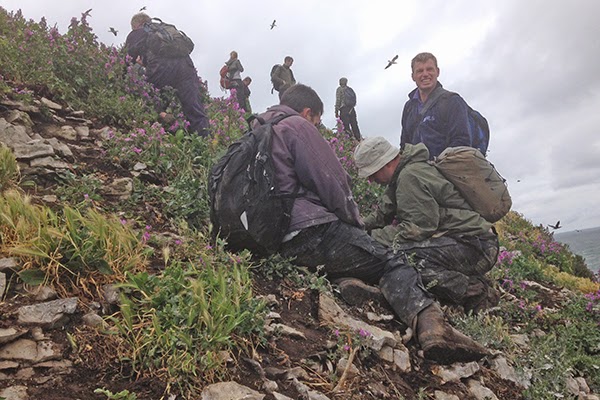














.jpg)






